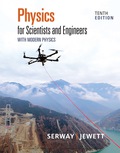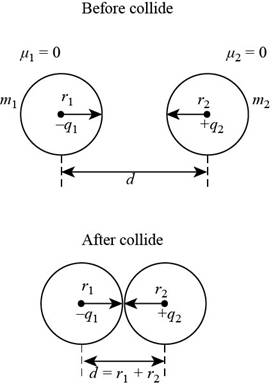
Concept explainers
(a)
The velocity of insulating charged sphere after collide.
(a)
Answer to Problem 18P
The velocity of insulating sphere 1 after collide is
Explanation of Solution
Given info: The radius of sphere 1 is
Consider the diagram of two insulating sphere having charge

Figure (1)
Write the expression to calculate the electric potential energy before collide,
Here,
Write the expression to calculate the potential energy after collide,
Here,
Add equation (1) and equation (2).
Write the equation of kinetic energy stored in charged sphere after collide, if velocity of charged sphere 1 is
Here,
From the law of conservation, both charged mass gets kinetic energy on diminishing of electric potential energy.
Then for equilibrium condition both energies will be same that is,
The negative sign shows that there is decrease in electric potential energy.
Substitute
Write the equation for conservation of momentum for final velocities of charged spheres.
Substitute
Substitute
Conclusion:
Therefore, the velocity of sphere 1 after collide is
(b)
The effect on velocity of spheres after collide if the sphere were conductor.
(b)
Answer to Problem 18P
The velocity of sphere will be greater for
Explanation of Solution
Given info: The radius of sphere 1 is
Due to polarization, the most of the positive charge of one sphere at the centre and most of the negative charge at the centre of other sphere will attracts each other due to which their average centre distance will be less then geometric centre distance. Hence potential energy will be less and kinetic energy will be more for conducting sphere, hence due to more kinetic energy velocities of conducting spheres after collide will be more.
Conclusion:
Therefore, the velocities of conducting sphere after collide will be more than velocities of insulating sphere after collide due to effect polarization.
Want to see more full solutions like this?
Chapter 24 Solutions
Physics for Scientists and Engineers with Modern Physics
- Pls help asaparrow_forward3. If the force of gravity stopped acting on the planets in our solar system, what would happen? a) They would spiral slowly towards the sun. b) They would continue in straight lines tangent to their orbits. c) They would continue to orbit the sun. d) They would fly straight away from the sun. e) They would spiral slowly away from the sun. 4. 1 The free-body diagram of a wagon being pulled along a horizontal surface is best represented by A F N B C 0 Ꭰ FN E a) A b) B c) C app app The app 10 app d) e) ס ח D E 10 apparrow_forwardPls help ASAParrow_forward
- Pls help asaparrow_forwardPls help asaparrow_forwardThe acceleration of an object sliding along a frictionless ramp is inclined at an angle 0 is 9. a) g tano b) g cose c) g sino 10. d) g e) zero A 1.5 kg cart is pulled with a force of 7.3 N at an angle of 40° above the horizontal. If a kinetic friction force of 3.2 N acts against the motion, the cart's acceleration along the horizontal surface will be a) 5.0 m/s² b) 1.6 m/s² c) 2.4 m/s² 11. d) 1.0 m/s² e) 2.7 m/s² What is the net force acting on an object with a mass of 10 kg moving at a constant velocity of 10 m/s [North]? a) 100 N [North] b) 100 N [South] 10 N [North} d) 10 N [South] e) None of these.arrow_forward
- Modified True/False - indicate whether the sentence or statement is true or false. If the statement is false, correct the statement to make it true. 12. An object in uniform circular motion has a constant velocity while experiencing centripetal acceleration. 13. An object travelling in uniform circular motion experiences an outward centrifugal force that tends to pull the object out of the circular path. 14. An object with less inertia can resist changes in motion more than an object with more inertia. 15. For an object sliding on a horizontal surface with a horizontal applied force, the frictional force will always increase as the applied force increases.arrow_forwardPls help asaparrow_forwardAnswer the given question showing step by step by and all necessary working out.arrow_forward
 Principles of Physics: A Calculus-Based TextPhysicsISBN:9781133104261Author:Raymond A. Serway, John W. JewettPublisher:Cengage Learning
Principles of Physics: A Calculus-Based TextPhysicsISBN:9781133104261Author:Raymond A. Serway, John W. JewettPublisher:Cengage Learning Physics for Scientists and EngineersPhysicsISBN:9781337553278Author:Raymond A. Serway, John W. JewettPublisher:Cengage Learning
Physics for Scientists and EngineersPhysicsISBN:9781337553278Author:Raymond A. Serway, John W. JewettPublisher:Cengage Learning Physics for Scientists and Engineers with Modern ...PhysicsISBN:9781337553292Author:Raymond A. Serway, John W. JewettPublisher:Cengage Learning
Physics for Scientists and Engineers with Modern ...PhysicsISBN:9781337553292Author:Raymond A. Serway, John W. JewettPublisher:Cengage Learning Physics for Scientists and Engineers: Foundations...PhysicsISBN:9781133939146Author:Katz, Debora M.Publisher:Cengage Learning
Physics for Scientists and Engineers: Foundations...PhysicsISBN:9781133939146Author:Katz, Debora M.Publisher:Cengage Learning College PhysicsPhysicsISBN:9781938168000Author:Paul Peter Urone, Roger HinrichsPublisher:OpenStax College
College PhysicsPhysicsISBN:9781938168000Author:Paul Peter Urone, Roger HinrichsPublisher:OpenStax College College PhysicsPhysicsISBN:9781285737027Author:Raymond A. Serway, Chris VuillePublisher:Cengage Learning
College PhysicsPhysicsISBN:9781285737027Author:Raymond A. Serway, Chris VuillePublisher:Cengage Learning





